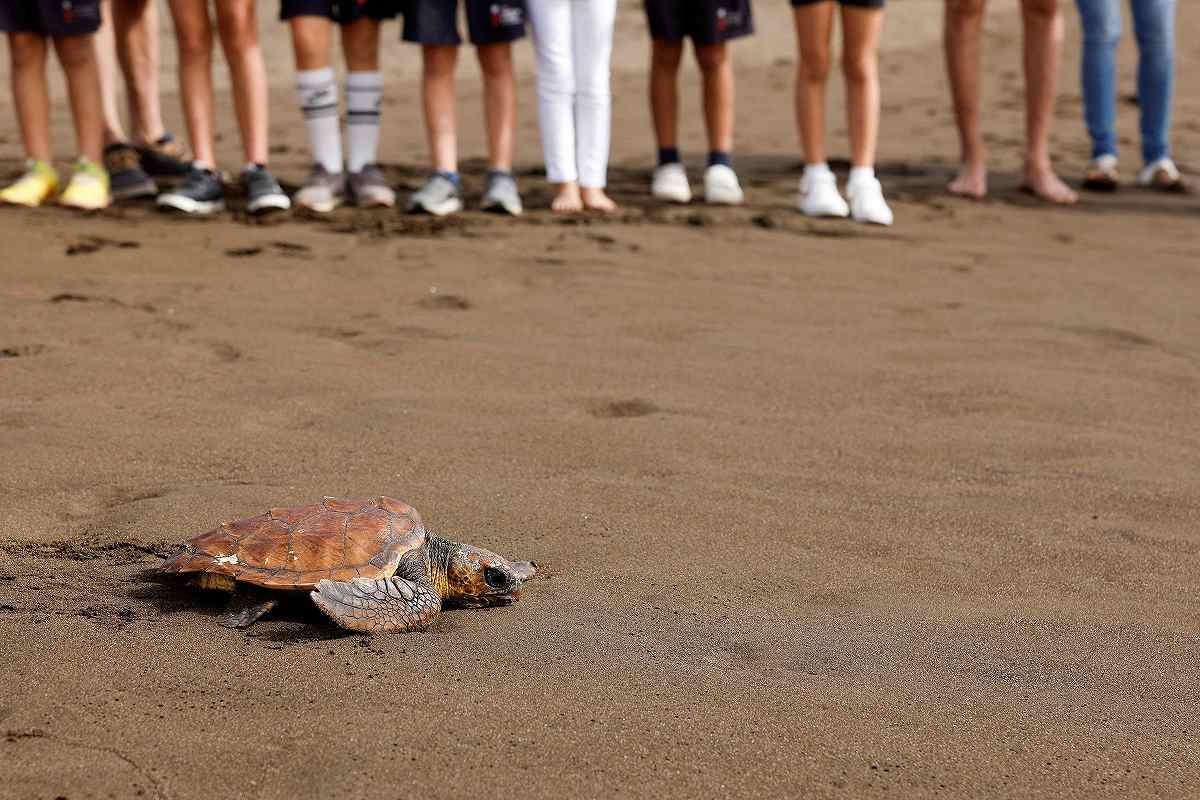
Schoolchildren observe a loggerhead sea turtle that was released on Melenara Beach, after recovering from its injuries at the Taliarte Wildlife Recovery Center, on the island of Gran Canaria, Spain, on March 30.
16:36 JST, May 9, 2023
TALIARTE, Spain (Reuters) — Growing numbers of loggerhead sea turtles are nesting and laying eggs on western Mediterranean beaches in what some scientists suggest could be a case of climate change causing habitat expansion of a threatened species.
Along with the warming sea water, another factor probably benefiting the world’s largest hard-shelled turtle, which is considered a vulnerable species, are protection programs in countries like Spain and Cape Verde.
Marine biologists from France, Italy, Spain and Tunisia have discovered far more nests on the beaches of their respective countries in the past decade than in 1990-2012, when those averaged less than three a year.
Since 2012, nest numbers have increased dramatically, reaching 84 in 2020, the most recent data available, according to a paper released by ecology scientific journal Global Ecology and Conservation last summer.
“We think this trend could be a new process of colonization,” said biologist Ana Liria, head of ADS Biodiversidad, a charity based in Taliarte on the island of Gran Canaria. The group rescues injured turtles in Spain’s Canary Islands and studies their population in Cape Verde, the eastern Atlantic’s main reproduction area.
Loggerhead turtles inhabit the warmer parts of world oceans and are present in the Mediterranean Sea, but they have mainly nested in a handful of places such as Florida, Cape Verde, Oman, Mozambique and Western Australia. They tend to return to their birthplace to lay eggs every few years.
The Mediterranean has become 1.3 C warmer between 1982 and 2019, according to a 2020 study by Valencia-based environmental foundation CEAM.
Climate change is usually detrimental to wildlife, but the warming waters have apparently become more suitable for the turtles, Liria said, cautioning however that their lifespan of up to 100 years means any behavioral change must be observed over much longer periods.
Successful turtle protection programs launched globally in the past decades have also boosted the turtle population, helping to lift their status above “endangered” level in many areas, she said.
A mature specimen can measure 90 centimeters and weigh 150 kilograms. Their size and hard shell generally protect them from predators, but fishnets, ship rotors and pollution have become significant threats.

A veterinarian of the Taliarte Wildlife Recovery Center, applies a laser treatment to an injured loggerhead turtle, on March 20.
"Science & Nature" POPULAR ARTICLE
-

Genome Study Reveals Milestone in History of Cat Domestication
-

Big Leap in Quest to Get to Bottom of Climate Ice Mystery
-

Japan Set to Participate in EU’s R&D Framework, Aims to Boost Cooperation in Tech, Energy
-

Paws on Parade: Nairobi’s Dogs Dazzle at ‘Pawchella’
-

Japan’s H3 Rocket Failed in Latest Launch, Says Official
JN ACCESS RANKING
-

Tokyo Economic Security Forum to Hold Inaugural Meeting Amid Tense Global Environment
-

Keidanren Chairman Yoshinobu Tsutsui Visits Kashiwazaki-Kariwa Nuclear Power Plant; Inspects New Emergency Safety System
-

Imports of Rare Earths from China Facing Delays, May Be Caused by Deterioration of Japan-China Relations
-

University of Tokyo Professor Discusses Japanese Economic Security in Interview Ahead of Forum
-

Japan Pulls out of Vietnam Nuclear Project, Complicating Hanoi’s Power Plans























